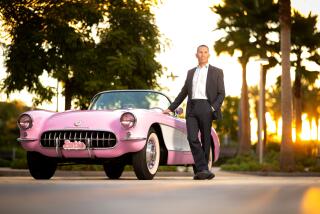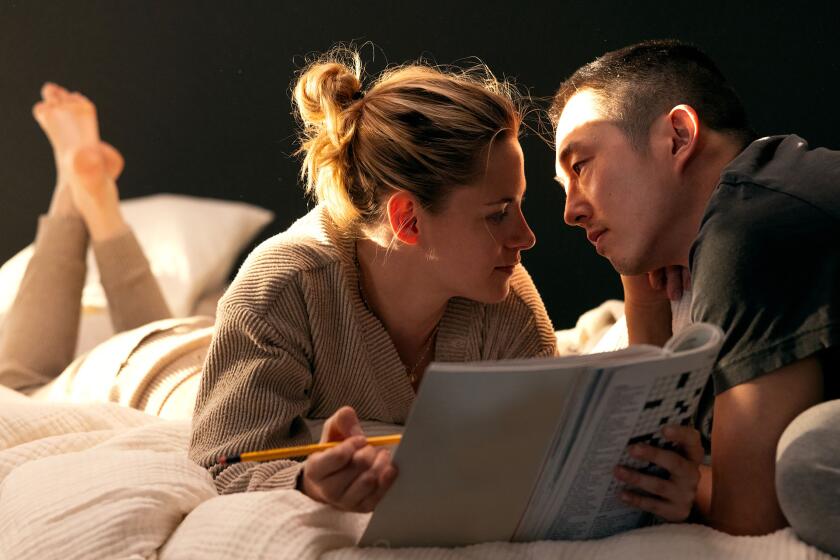Two Girls Are Turning Heads in Hollywood
- Share via
In a noisy summer of cyclones and space aliens, two brainy, plucky little girls with retro names have quietly made an impression in Hollywood.
Countering the conventional wisdom that films based on such characters are doomed to fail, “Harriet the Spy” and “Matilda” have both found their audience, while taking radically divergent approaches in doing so.
When he embarked on making “Matilda,” the film adaptation of Roald Dahl’s story of a little girl with supernatural powers, actor-director-producer Danny DeVito refused to be scared off by examples set by such box-office failures as last year’s “A Little Princess” or “The Baby-sitters Club.”
To prove it, DeVito, and his production company, Jersey Films, made one of the highest-budgeted family features of the summer--complete with special effects and many shots featuring dozens of children pulling unusual stunts--in an effort to stay true to the original classic story.
“The movie’s told from a kid’s point of view,” DeVito said. “I didn’t worry about whether this had worked before. I just thought about empowerment and making sure kids didn’t get talked down to. And I think kids are really responding to it.”
Indeed, “Matilda” opened to large audiences last weekend, grossing $8.2 million and taking third place behind “A Time to Kill” and “Independence Day.” The movie is holding its position this week, according to John Krier, president of Exhibitor Relations, which tracks box-office receipts.
“We’ve broken one of the rules: They say you can’t make a successful movie with a girl as a protagonist,” DeVito said. “It’s like, ‘Hallelujah! Let’s throw our hands in the air!’ But boys really like the movie too. . . . We trust the kids and they lead the way.”
“Matilda’s” figures are close to the figure reached by “Babe,” last summer’s family hit, which opened at $8.8 million.
But with a budget acknowledged by its producers to have reached $35 million (although published reports have put the figure closer to $50 million), “Matilda,” which stars DeVito, Rhea Perlman and Mara Wilson, is one of the more expensive live-action children’s films in recent memory. (To turn a profit, a loose rule of thumb is that a film will have to bring in from worldwide box office, video sales and television more than double its production and marketing costs.)
In contrast, “Harriet the Spy,” was made for just $12 million. It opened July 10 at a respectable $6.6 million, in fifth place at the box office, and has brought in $24 million to date.
The makers of each film say they are happy to turn a Hollywood truism on its head.
“It’s absolutely time for that rule to bite the dust,” said Theresa Rebeck, screenwriter of “Harriet the Spy.” “There are a lot of really stupid rules in Hollywood. There are some rules that are just misperceptions and that’s all this was.”
Both “Harriet the Spy,” which stars Rosie O’Donnell and Michelle Trachtenberg, and “Matilda” are PG-rated adaptations of classic children’s stories. The makers of both films insist that having an abiding commitment to the project and influence in the industry has been the only way to green-light a movie targeted to little girls.
“It’s pushing a boulder up a mountain to make a movie about a girl,” said Debby Beece, president of Nickelodeon Movies, which co-produced “Harriet the Spy” with Paramount Pictures. “It requires a real perseverance, passion and clout. If you don’t have those three things, it’s not going to happen.”
The key for makers of “Harriet the Spy”--a story kicking around Hollywood, bouncing among three studios, for the last two decades--was to work within a tight budget, while updating the ‘60s-based source material to a ‘90s sensibility.
“We had a very different mind-set [from “Matilda”],” Rebeck said. “Everybody was aware from the start that we had to make this on a budget.”
It was the first studio picture for the film’s director, Bronwen Hughes, a top commercial director from Canada. The film was shot in Toronto, rather than New York City, where the story was set. Several bigger-name stars were passed over, to cut costs. Consequently, the film came in under its expected budget of about $15 million, producer Mary Kay Powell said.
In contrast, “Matilda’s” budget grew by leaps and bounds when it went 45 days over its shooting schedule, said a source close to the production. But, the source added, “it wasn’t irresponsible, it was the quest for the perfect film on Danny’s part.”
Just where did all the money spent on “Matilda” go?
“Danny is a true filmmaker with a unique visual style, so he didn’t just set up six cameras and hope he had some decent stuff to cut together. He made it like a real film,” said “Matilda” producer and Jersey Films President Stacey Sher.
“Danny’s a sweet man with a very forceful personality,” said Sid Ganis, former president of worldwide marketing for TriStar Pictures, the studio that made “Matilda.” “He knows what he’s doing and how he wants to do it. That kind of conviction sometime leads to spending a few extra bucks. And often it’s worth it.”
Some of those extra bucks went to numerous elaborate special-effects shots.
“To get those incredible performances with stuff flying through the air and with so many kids in the shot takes a very long time,” said another source close to the production. “Kids can only work for a very short period of time. And there was a child actor in almost every frame of the movie. . . . Look how quickly any films with effects become $50-, $60-, $70-million movies. You could say that ‘Jumanji’ was a kid’s movie and it probably cost more than that. We weren’t too far off if you define it by ‘Jumanji’ costs. It wasn’t too far away from what the average Hollywood film costs.”
“Harriet the Spy” producer Powell sees the films as flip sides of the Hollywood coin.
“I’m thrilled if two girl movies can be out there,” Powell said. “Maybe ‘Harriet’ is the art film of children’s movies and ‘Matilda’ is the commercial movie.”
More to Read
Only good movies
Get the Indie Focus newsletter, Mark Olsen's weekly guide to the world of cinema.
You may occasionally receive promotional content from the Los Angeles Times.










